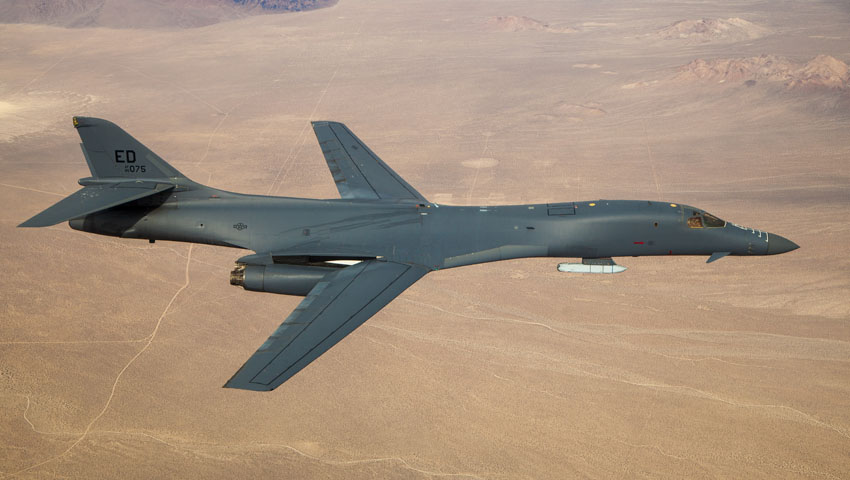A US Air Force B-1B Lancer attached to the US Air Force’s 412th Test Wing’s 419th Flight Test Squadron (FLTS), Global Power Combined Test Force, has successfully carried an inert Joint Air-to-Surface Standoff Missile under an external pylon for the first time.
To continue reading the rest of this article, please log in.
Create free account to get unlimited news articles and more!
The captive carry flight was the culmination of the numerous ground tests that began with last year’s expanded carriage demonstration that included a modified internal bomb bay, which featured a moveable bulkhead, the demonstration showcased a configuration of the B-1 that would allow the aircraft to carry larger-sized weapons both internally and externally.
US Air Force General Timothy Ray, commander of Air Force Global Strike Command explained the importance of the demonstration, saying, "Adapting a small number of our healthiest B-1s to carry hypersonic weapons is vital to bridge between the bomber force we have today, to the force of tomorrow.
"This is a major step forward in our global precision fires capability and it is important we pursue these technologies to remain ahead of our competitors. My goal is to have a limited number of B-1s modified to become the roving linebacker of the western Pacific and the north Atlantic."
The B-1B was initially designed to incorporate a movable bulkhead and usable external hard points for its original nuclear mission, however the US shifted the aircraft’s mission to conventional weapons in 1994, the physical conversion to conventional-only armaments started in 2007 with the Strategic Arms Reduction Treaty, or START, and was finished in 2011.
The current expanded carriage demonstrations will keep the aircraft compliant with the New START agreement, which means the B-1 can once again utilise those features while delivering conventional weapons.
Major Bret Cunningham, a B-1B test pilot with the 419th FLTS, said, "We’re essentially displaying our external weapons carriage capability. We have a JASSM weapon on what is traditionally the targeting pod pylon on the forward right hard point, so we are demonstrating that the B-1 has the capability to carry weapons and employ them externally."
The demonstration could mean a potential boon for combatant commanders as the increase in weapons stores remedies an immediate shortfall due to the limited number of strategic bombers, the proposed increase in capacity means that two bombers would equal three bombers’ worth of weapons.
Maj Cunningham added, "Since the long-bay demo last year, this has really been our key focus point in 2020; getting ready for this external weapons-release demo as kind of the next step in that progression towards external weapons carriage and hypersonic capabilities for the B-1. We’re pretty close to the culmination of this demo event and reaching that next milestone."
Following the captive carry mission, engineers will then review the data gathered from the flight before moving on to the next phase of the demonstration; an external weapons release.
Engineers within the Air Force Test Center (AFTC) enterprise, B-1 system program office and Boeing will verify both the weapon’s and pylon’s integration with the B-1B, they are also interested in the physical effects, software and flying qualities of the new shape on the outer mold line of the aircraft, Maj Cunningham explained.
Major General Christopher Azzano, AFTC commander added, "The Air Force Test Center is enthusiastically teaming with Global Strike to enable greater flexibility in B-1B operational payloads. The external carriage and long-bay mods reflect our ability to keep weapon systems relevant with mid-life upgrades."
This demonstration does not affect the US Air Force’s request to retire 17 B-1B bombers in 2021.
JASSM is a long-range, conventional, air-to-ground, precision standoff missile for the US and allied forces, the JASSM is designed to destroy high-value, well-defended, fixed and relocatable targets, JASSM’s significant standoff range keeps aircrews well out of danger from hostile air defence systems.
A 2,000-pound class weapon with a penetrator/blast fragmentation warhead, JASSM employs precision routing and guidance in adverse weather, day or night, using a state-of-the-art infrared seeker in addition to the anti-jam GPS to find a specific aimpoint on the target, its stealthy airframe makes it extremely difficult to defeat.
JASSM is integrated on the US Air Force's B-1B, B-2, B-52, F-16 and F-15E. JASSM-ER is integrated on the B-1B, the F-15E and is currently completing integration for the internal bay and wings of the B-52H, and F-16C/D. Internationally, JASSM is carried on the F/A-18A/B and the F-18C/D aircraft.
Future integration efforts will focus on the US and international versions of Lockheed Martin F-35 Lightning II fighter aircraft and other international platforms.
Stephen Kuper
Steve has an extensive career across government, defence industry and advocacy, having previously worked for cabinet ministers at both Federal and State levels.

 Login
Login








